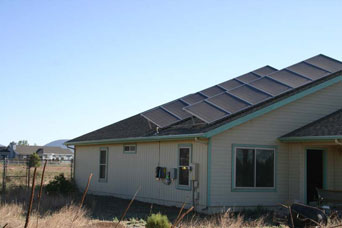It could pay to live in the sunniest state in the nation.
If you have considered installing solar panels on your home, a case study by a team of NAU researchers suggests you won’t get burned by your investment.
“It seems that Arizona is poised to substantially add to the solar profile of our total energy product,” said Dean Howard Smith, professor of economics and applied indigenous studies and the director of the business and policy programs in the Sustainable Energy Solutions Group. “The new federal tax credit on a solar panel system makes an investment financially worthwhile.”
The Sustainable Energy Solutions Group consists of faculty members from the College of Engineering, Forestry and Natural Sciences and The W.A. Franke College of Business who work with industry, policy makers and national laboratories to devise sustainable energy solutions.
Smith, along with David Allen, associate professor of finance, and Chelsea Ann Atwater, undergraduate research assistant, researched and co-authored “You Can Make a Positive Return by Investing in Residential Solar Systems: An Arizona Case Study.”
Using today’s new 30 percent federal tax credit with data collected from August 2007 to September 2008, the paper is a 14-month case study of the production history of a 2,919-watt solar system installed at Smith’s residence.
The study calculated the net present value of the savings on APS electricity bills over the 25-year lifespan of the system and concluded that the out-of-pocket expense will be paid off in 10.6 years and afterward the system will provide “free” electricity.
“Given what has been happening to my other investments recently, the solar system has turned out to be a very good one,” Smith stated. “The return on investment we have estimated under the new federal program is a very good return.”
As for the out-of-pocket expense, the sticker price of the solar system was $22,393. The new federal tax credit would have shaved $6,418 off that price. Arizona offers a state tax credit of 25 percent of the installation price, with a maximum credit of $1,000, which reduced the cost by another $1,000. And after APS’s Environmental Portfolio Standard Credit Purchase Program paid $8,736, the out-of-pocket expense amounts to $6,239—a savings of $16,154.
“There is money from three different agencies to put into a solar system now,” Allen said. “For anyone concerned about rising energy prices, here’s a way to have a locked-in energy cost, even if APS rates rise.”
Besides saving money, a solar system helps save the planet too—the estimated savings of carbon dioxide by using electricity from the sun instead of from coal-based production is 135 tons of CO2, or the equivalent of roughly 13,500 gallons of gasoline worth of CO2.
Read the full case study here. For information on solar systems in Arizona, view the Arizona Solar Center’s Arizona’s Consumer Guide to Buying a Solar Electric System.



